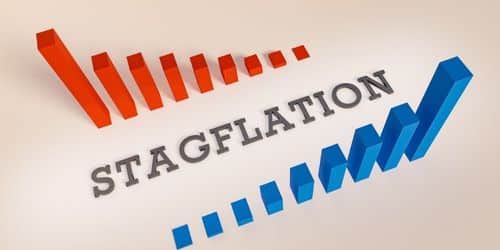We say that the economy is experiencing “stagflation” when growth is slow, unemployment is high, and prices are going up all at the same time. This article talks about stagflation in the US in the 1970s.
What’s Stagflation?
A stagflationary economic cycle is marked by low economic growth, high unemployment, and prices that keep going up. This is hard for people who make economic policies because fixing one problem often makes the other one worse.
Understanding Stagflation
Iain Macleod, a British politician, first used the word “stagflation” in a speech to the House of Commons in 1965, when the British economy was in a tough spot.
He came up with the word “stagflation” to describe a situation in which there is both inflation and low growth.
During the oil crisis of the 1970s, which led to a recession with negative GDP growth for five straight quarters, the world got a new lease on life in the United States. In 1973, the rate of inflation doubled, and in 1974, it hit double digits. In May of 1975, 9 percent of people were out of work.
Since the 1970s oil crises, the developed world has had stagflation many times, even though experts used to think it was impossible.
Stagflation in the US
By the middle of 2022, many analysts thought that the United States had not yet entered a period of stagflation, but that it was likely to do so soon. There hasn’t been this much inflation in the United States or around the world in a long time. Most of the time, these rising prices are caused by problems with the supply of goods and changes in what customers want.
Companies had to close for weeks or months because of the pandemic. This is still a problem in China, the world’s largest manufacturer, where strict lockdowns to stop the spread of infection have made it hard for ports and manufacturing facilities to work normally.
Russia’s invasion of Ukraine has made the situation far worse, halting Russian oil and gas exports and driving up energy prices worldwide. Ukraine is one of the world’s biggest wheat producers, and Russia’s blockade of grain shipments from the country has caused food prices to rise around the world and raised fears of famine in the developing world.
Partly because of these problems, the world economy is growing more slowly. The World Bank cut its annual growth forecast from 4.1% in January to 2.9% on Tuesday. This is the biggest drop the global economy has seen after an initial rebound after a recession in more than 80 years.
But What Happens if Stagflation Lasts for a Long Time?
If wealthy economies have been going through stagflation for years, something has gone very wrong. Most of the time, stagflation can be fixed by making changes to monetary policy that lower inflation and let the market do what it does best, which is to reduce unemployment. The goal is to send a market that is stuck between inflation and deflation into a recession, which usually lasts a year or less.
That could mean trouble for consumers in the United States, the Eurozone, and Japan, and it could also mean the loss of hundreds of thousands of jobs. But once the economic downturn is over, wages will go up, investment markets will recover, and businesses will start hiring again. When wages go up with inflation, they tend to stay higher even when inflation slows down.
Brazil, Russia, India, China, and South Africa are just a few examples of emerging and developing economies that pose a serious long-term threat. All of these countries are big exporters, and their economies depend on other countries buying their goods. If the global economy goes down, especially the consumer sector in the West, there will be less demand for goods from emerging countries.
Both of these countries’ economies depend on foreign investment, but when global markets are unstable, companies tend to stay away from the higher-risk economies of developing countries. If this leads to credit crises in emerging market countries, it could slow down the recovery of the world economy.
What Makes Stagflation Happen?
Economists argue a lot about where stagflation comes from, but there is no clear winner. Once, that was thought to be impossible, but now many ideas have been put forward to explain it.
#1. It’s Because of Bad Economic Policy
One other possibility is that both the rise in prices and the lack of economic growth are caused by bad economic policy. In an economy with inflation, too many rules about markets, goods, and labor can lead to stagflation.
Others say that former president Richard Nixon’s actions contributed to the economic downturn of 1970, which some people see as a precursor to stagflationary times in the future. Nixon tried to stop inflation by putting taxes on imports and putting a 90-day price freeze on goods and services.
After the limits were lifted, prices went up quickly, which caused economic chaos. Even though it sounds good, this makeshift explanation for stagflation in the 1970s doesn’t work for other times when prices went up and unemployment went up as well.
#2. What Went Wrong With the Gold Standard?
Some people have said that money could be a factor in stagflation.
Nixon got rid of the last ties to the gold standard, which brought down the Bretton Woods system that had controlled the exchange rates of different currencies.
By doing this, the decision removed all practical limits on monetary expansion and currency devaluation, since the U.S. dollar and the vast majority of global currencies are now based on fiat instead of a commodity.
#3. We Could Blame This on Sudden Changes in Oil Prices
One idea is that stagflation happens when the price of oil goes up quickly and causes the economy of a country to slow down. In the 1970s, there was a shortage of oil, which is a great example. In October 1973, OPEC put a ban on trade with Western countries. As a result, the price of oil around the world went through the roof, which pushed up inflation and caused more people to lose their jobs.
Even though more people were losing their jobs, prices went up because the cost of transportation for production and distribution went up. People who disagree with this idea say that none of the inflation and recessions that have happened since the embargo have been accompanied by big jumps in oil prices like those in the 1970s.
Stagflation in the 1970S
Stagflation was thought to be impossible in the 1970s at one point. During most of the 20th century, it wasn’t taken into account by the economic theories that were used to make most decisions and do most research. For example, the Phillips Curve theory, which came about during the time of Keynesian economics, showed how unemployment and inflation are related to the macroeconomic policy as a trade-off.
Deflation became a concern for economists around the time of the Great Depression and the rise of Keynesian economics. They said that trying to lower inflation usually causes unemployment to go up, and that trying to lower unemployment usually has the opposite effect and causes inflation.
At the end of the 20th century, when stagflation happened in the industrialized world, this was shown to be false. Stagflation reveals that real-world events can upset economic theory and policy. Since then inflation has remained strong even during economic downturns.
Consumer prices have risen every year during the past 50 U.S. recessions. Even at the lowest moment of the financial crisis in 2008, energy and transportation prices fell while everything else rose.
In the 1970s, the federal budget deficit grew quickly because of spending on the Vietnam War, the Great Society programs that tried to fight poverty, and the collapse of the Bretton Woods agreement.
More Information
As if that wasn’t awful enough, the Arab oil embargo tripled crude oil prices, and the US wouldn’t let other countries buy Iranian oil at the end of the decade, almost tripling them again. In November 1979, West Texas Intermediate crude oil reached $100 in 2019 currency and peaked at $125 in April. No one would pay more than that for the next 28 years.
Wages and other costs across the economy rose due to energy price increases. During this time of economic instability, unemployment went up, but inflation didn’t change. Instead of trying to keep inflation under control, the Federal Reserve boosted growth. After several external shocks, the government delayed investment due to inflation fears.
More Details
The average unemployment rate was higher than 20 years earlier, and the economy was growing unevenly. The economy went down both from December 1969 to November 1970 and from November 1973 to March 1975. When the economy wasn’t in a recession, economic growth was strong. In 1972–73 and 1976–78, real gross domestic product (GDP) growth was over 5%. But oil price shocks in those years slowed growth and made inflation worse.
The whole country had low morale because of high inflation and unpredictable economic growth. According to Gallup, the number of cheerful Americans has increased from 19% in November 1979 to 22% in April 2022. In 1999, 71% of Americans were satisfied with the country’s direction, the highest ever. In general, living standards went down during the 1970s, and people lost faith in economic policies.
Is Stagflation Occurring for the First Time?
Yes. The economy went through stagflation from 1973 to the beginning of the 1980s. Oil exports to the US, UK, Canada, and other countries were stopped because they helped Israel during the Yom Kippur War. This caused already high commodity prices to rise even further.
This caused a number of economic factors to come together in a way that could be very bad. In less than a year, the price of oil tripled. Most basic goods cost more than they did before. In response to the price shocks, companies cut their staffing levels, which made unemployment more common. Policymakers were surprised by this because they thought that inflation and unemployment would go hand in hand in the opposite direction.
Regulators in the U.S. didn’t have the plan to fight stagflation, and they were wrong. In the end, Western economies were able to compete with sometimes hostile exporting nations by increasing their own capacity to make commodities. However, it took a long time for this to happen because the crisis lasted so long.
Is Stagflation Worse Than Recession?
The term “stagflation” is used to describe an economic cycle with persistently high inflation, high unemployment, and slow economic growth. This is different from a recession, which also has an economic downturn and generally high unemployment, but inflation is less of a concern.
What Is Stagflation in the Economy?
When inflation is high and growth slows, the economy is said to be in a “stagflation” state. Inflation makes prices go up, but it also makes it harder to buy goods and services.
What Is a Stagflation Example?
If, say, the price of oil suddenly and unexpectedly went up, prices everywhere would go through the roof and profits would go down. Stagflation happens when prices go up and profits go down at the same time.
What Is Stagflation Caused By?
Stagflation occurs when the economy stagnates, prices don’t rise, and unemployment rises. Excessive government expenditure, low-interest rates, and supply-side shocks like oil price spikes can also cause this.
What Should I Invest in During Stagflation?
If you want to keep your money safe from stagflation, you can buy real estate, trade commodities, invest in value companies, or buy gold and other precious metals.
Is It Good to Buy a House During Stagflation?
Overall, stagflation would hurt first-time homeowners the most because rising interest rates would push them out of the market quickly. If wage growth keeps up with inflation, these people should be in the same financial situation as they are now.
How Long Does Stagflation Last?
Academic research shows that stagflation hit seven of the world’s largest market economies between 1973 and 1982. As inflation rates started to go down in 1982, economists stopped focusing on what caused stagflation and started looking at “determinants of productivity growth and the effects of real wages on the demand for labor.”
Conclusion
Most economists and politicians assume that prices will keep going up, so they focus on ways to speed up or slow down inflation instead of trying to figure out what inflation is. But since then, it seems that when the economy is down, prices go up and the economy stays the same. As there is no effective treatment for stagflation, economic leaders must do everything they can to stop it.
Stagflation FAQs
How can we avoid stagflation?
- Spread out your money in several places.
- Deal in short-term debt.
- Effortlessly reduce running expenses.
- Embrace Robotic Process Automation.
- It is time to reevaluate your prices and enhance the quality of your offerings.
- Attempt to minimize or get rid of your debt.
- Purchase a new company or assets.
In stagflation, what business is best?
During stagflation economies, defensive sectors like utilities, energy, consumer staples, healthcare, and real estate tend to do well, while cyclical sectors like technology, industrials, and financials tend to do poorly.
Who ended the stagflation?
Federal Reserve chairman Paul Volcker of the United States eventually ended the prolonged stagflation by dramatically increasing interest rates in an effort to implement a disinflationary government policy.
Related Articles
- RECESSION VS DEPRESSION: What Are the Differences? (Detailed Guide)
- CANADIAN BEER BRANDS: 20 Best, Old and Cheap Brands in 2023 (Updated)
- POTATO CHIP BRANDS: 2023 List of the Oldest Potato Chip Brands (Updated)
- RECESSION: What It Means, Examples & What to Do During Recession
- WHERE TO INVEST DURING INFLATION: Best 2023 Investments, Revealed!
- HOUSING MARKET RECESSION: Impacts of Recession In 2023
- WHAT IS A BANK ABA NUMBER? How It Works.





